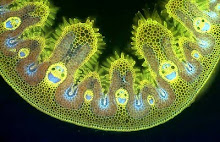A packet of seeds is still one of the best bargains around and you can germinate, grow and flower this tropical vine - the cup-and-saucer vine Cobaea scandens - in a single season, although in its native tropical America it grows as a perennial. In the UK you can grow it outside against a sunny wall, but it flowers more reliably in a conservatory, where it will quickly climb to the roof, clinging on with slender tendrils.
It's pollinated by bats and at dusk - at about the time that bats would emerge - the flowers emit a musty scen that attracts them. The bats visit for nectar but as they probe the flower those protruding stamens dust their furry chests with pollen that they transport from plant to plant. Cobaea pollen grains have an extraordinarily beautiful pattern of hexagons and pores on their surface when viewed under the microscope.
Pancrace Bessa, Flore des Jardiniers, 1836

























